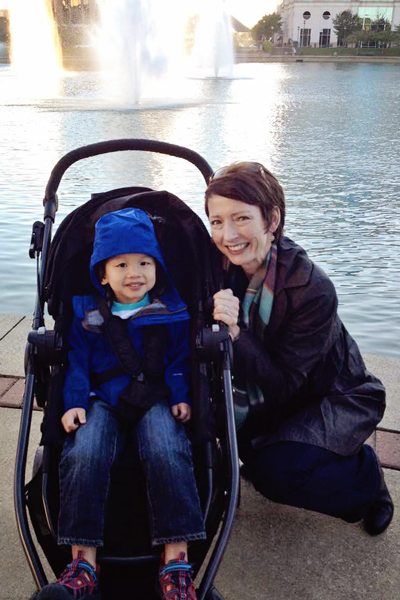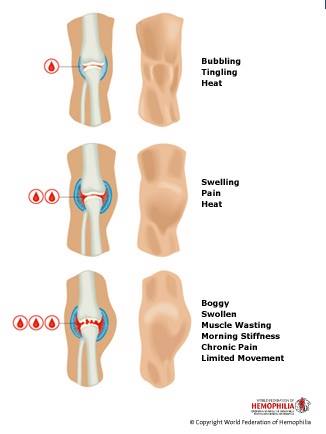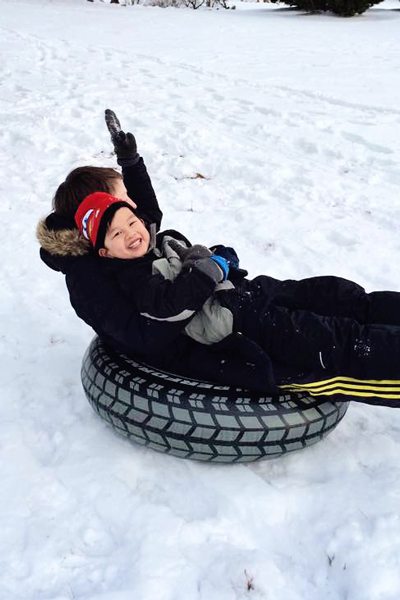In honor of Hemophilia Awareness Month, I wanted to write a post to help other adoptive parents understand what can be involved in adopting a child with hemophilia.
My son, who came home from China in 2013, has severe Hemophilia A (the most common type of hemophilia), which means that his body does not make one of the proteins necessary to make his blood clot (Factor VIII, commonly denoted as FVIII). These clotting proteins work together and stack up much like the row of dominoes you might have pushed down as a child to watch each domino fall in turn, in a neat row. But, when one is missing, the chain reaction doesn’t happen. For blood clotting, that can be a serious problem.
Although individuals with hemophilia don’t bleed faster than a typical person, they bleed longer, both externally and internally, than those of us whose clotting processes work normally. The biggest danger for these children (and adults) is internal bleeding into joints, muscles, internal organs, and in the head, which can damage the brain. Joint bleeds can cause crippling damage without treatment. The good news is that hemophilia can be treated, and these children can live long, healthy, active lives without joint damage. Without treatment, the average lifespan is 24 years.
Aside from clotting differences, these children are no different from any other child. My son is bright, funny, and inquisitive. He loves to laugh, he loves to build things, and I love him to pieces. Before he came home, like any good adoptive parent, I read everything I could get my hands on to understand his condition because, frankly, I knew very little about life with hemophilia. I found many resources for parents of children with hemophilia. I joined Facebook groups for mothers of children with hemophilia. And, I read Raising a Child with Hemophilia. But, I found that there were few resources available to help me understand the unique challenges and blessings associated with adopting a child with hemophilia. Thus, in this post I list a few of the things I have learned along the way (and that I wish I had understood ahead of time) to help other parents who choose to adopt one of these precious boys!
Medical Care Here and There
Before my son came home, I knew the basics about hemophilia treatment. But I didn’t understand the differences between treatment approaches in the United States and China or the potential effects of these differences on my son. The main treatment approach for hemophilia is to replace the missing clotting protein (factor) either “on demand” (as needed for a bleeding event) or on a regular basis to prevent bleeding (called prophylaxis). Prophylaxis is the standard of care for severe hemophilia in the US. And, synthetic factor concentrate products are widely available in the US, whereas cryoprecipitate from human blood products is more readily, but not widely, available in China. Many children are treated on an “as needed” basis for severe injuries (e.g., a scalp hematoma). Otherwise, they do not get treatment and endure painful joint bleeds that can eventually result in immobility and joint damage. Some children are fortunate to receive regular, prophylactic infusions of factor in China, but this is rare.
In addition, infusions themselves are typically very different in China than in the US. Cryoprecipitate takes longer to infuse because it takes more of this product to replace a child’s missing factor. Thus, children must endure overnight, and often multi-night, hospital stays for treatment – when they are fortunate enough to receive it. In the US, infusions of synthetic factor concentrate products happen in minutes, usually in the child’s home. So, treatment may have been more traumatic for our boys prior to their coming home than it will be in the US. Those memories may affect our boys’ responses to treatment here.
That said, I have found that there are also benefits of these differences in treatment approaches. Our boys understand well the painful effects of their condition. Children with severe hemophilia in the US receive prophylactic treatment from a very early age, so they may never experience the devastating, painful effects of a joint bleed. My son, on the other hand, is well aware of his inability to walk and his “owie” knees in China. He willingly participates in his infusion treatments via peripheral IV at home because he KNOWS what happens when he doesn’t have factor.
Comprehensive Care Approach
in the US we have a wonderful, federally-funded system of treatment centers, called Hemophilia Treatment Centers (HTCs), that provide comprehensive care to our children. They have a multi-member team devoted to all aspects of hemophilia care, including a hematologist, a nurse coordinator, a social worker, a physical therapist, and an education specialist. We see the whole team every three months. This will go to 6 months and then yearly as my son grows. I can’t say enough good things about the comprehensive care approach. I have learned from the wonderful team at my HTC how to manage my son’s condition and let him live as an active, joyful, lively child. I don’t wrap him in bubble wrap and worry about every bump and fall. He runs, plays, and lives life joyfully; if he has a bleed, we treat it. This is a very manageable condition.
Invest in a Stroller
Fortunately, I had a hunch that a good stroller may be important if my boy had painful joints. (I was also lucky that he was toddler age and could be easily carried at 30 lbs. when I met him.) I would recommend highly that you find a stroller that will work for your child even when your boy is bigger than toddler age. I have used our stroller a number of times when my son had joint bleeds here in the US. While in China, I bought an umbrella stroller for our in-country outings.
I also learned that children with hemophilia in China are often restricted from many activities because falls and twists can cause joint bleeds. So, their gross motor development may be delayed, and they may not be accustomed to all the walking you will do while in country for your adoption trip. Additionally, if they have suffered joint bleeds, they may have painful joints and need to be carried or wheeled around. Treatment and regular activity will help strengthen joints once you get home, but healing takes time and requires supports!
Growth Rate and Factor Dose
In my son’s first year home he gained 9 pounds and grew 5 inches. That’s double the average growth rate for a typical toddler, but it is not surprising for a child coming to the United States from an institutional setting. Although I knew that my son’s factor dose was based on weight, I didn’t realize how important it would be to monitor changes in his weight regularly. What I (finally) realized was that my son would have periods of no joint bleeds when his factor dose matched his weight. Then, he would get several bleeds in close succession, and we would realize that he had grown and was under-factored relative to his weight. In other words, he outgrew his factor dose far more often than a typically developing child in that first year.
Because our sons’ growth is often so much more rapid than typical children, our Hemophilia Treatment Centers may not be aware that growth can be an issue. So, my advice to you is to invest in a scale, and track your child’s weight in kg. Laurie Kelley’s book, Raising a Child with Hemophilia (see link above), has a dosing chart as an appendix in the back, and you can use that to see whether your child is getting the appropriate dosing amount. (I took a picture of that chart and keep it in my smart phone!)
Joint Bleeds
Joint bleeds are the most common complication of hemophilia, and they can be life altering because they can lead to joint damage over time and with repeated bleeds. However, having no experience with hemophilia, I was not sure what to look for with my son’s joints. This may seem silly, but when I thought about anything labeled a “bleed,” I thought it would probably look red, or at least bruised and discolored. When I Googled images of joint bleeds I saw horrendous pictures of big, discolored joints. But, I really wasn’t sure what to look for in my son. I can tell you now, after several joint bleeds, that you may not see much of anything at first!
When a joint bleed begins, small capillaries begin bleeding into the joint space. It may feel bubbly to your child. He may say it tickles or itches, and it may be painful before you can ever see visible signs of the bleed. If you feel the joint and it’s warmer than its counterpart on the other side of your child’s body, if your child’s movement is affected, or if the joint begins to look puffier than its counterpart, your child may well have a bleed.
Earlier treatment is better. So, waiting until the joint is noticeably bigger or more discolored than a typical joint is not a good idea! Look for small signs: changes in movement, using the left hand instead of the right, holding an arm or leg differently than normal, limping, warmth in a joint, and complaints of pain, even when the joint may not yet be noticeably different, should all be taken seriously.
Target Joints
When children and adults with hemophilia experience joint bleeds, their joints become more apt to bleed in the future. Think of a sprained ankle. When you sprain an ankle, even if it has healed, a trip or fall is more likely to injure that formerly injured joint. Our boys’ joints are the same. With repeated bleeds, certain joints may be more prone to bleed with even minor injury or activity. Hematologists refer to these bleed-prone joints as target joints, and treatment is often designed to prevent repeated bleeds such as these in order to preserve joint health and prevent permanent damage.
Pain Tolerance
As I’ve mentioned, joint bleeds are extremely painful. Imagine your knee joint space filling with blood, which makes it swell to the point that you cannot even move your knee at all. Children with hemophilia who have not experienced adequate treatment have often experienced extreme pain. They know how to move to avoid putting pressure on the affected joints. (My son could scoot on the floor with a knee or ankle off of the ground without even thinking about it, and he had calluses on the palms of his hands as evidence that this was not new to him.)
Because they have learned to tolerate high levels of pain, they may not realize when a bleed is beginning, which makes it that much more important for you to watch for signs in activities and behaviors (as I described above). The heightened pain tolerance may also make our boys more tolerant of the tiny pain associated with infusions of factor. A small stick is nothing compared to a hot, swollen, painful joint. In fact, reminding my son of his painful knees in China has helped him to cooperate with his treatment. He will say, “Mommy, tell me again why I need factor?” And, I begin with, “Remember your owie knees in China?…”
Treatment Processes and Costs
Hemophilia treatment is expensive but is covered by insurance. The standard of care for severe hemophilia is prophylactic treatment, which means regular infusions of your child’s missing clotting factor 2, 3, or more times per week in your home, usually with the aid of a home health nurse. This means that you will deal with multiple companies that serve your child’s needs, all coordinated by your Hemophilia Treatment Center.
A specialty pharmacy supplies your child’s clotting factor and the infusion supplies (e.g., needles, syringes, gauze, band-aids, alcohol wipes, gloves, basically all the things you need to do infusions at home), which are sent to your home on a regular basis. A home health company provides the nursing care, and the Hemophilia Treatment Center manages all aspects of care, coordinating with the pharmacy and the nursing company.
It took me a little while to understand who did what, who sent what to my house, and who I should talk to about all the little nitty-gritty aspects of my son’s care. It also took me a while to understand that the infusion supplies, which take up one kitchen cabinet in my house, are OUR supplies not the nurse’s supplies! These things will all fall into place. Our specialty pharmacy is terrific, even down to sending the particular character band-aids my son prefers. Although factor medication is costly, insurance covers that cost, and the factor manufacturers offer co-pay assistance programs to help families. Baxter, for example, offers $12,000 per family per year to help cover out-of-pocket costs, which more than covers my deductible for my son.
Questions to Ask Your Agency or Your Child’s Guardians
If you are in the process of adopting, you will want to know what kind of hemophilia your child has. Hemophilia A (where a child is missing Factor VIII) is most common, and Hemophilia B (where a child is missing Factor IX) is next most common. There are other types, and treatment depends on the type. Your child’s institute may not have access to that test, though. I can tell you that all but one of the children I’ve seen with hemophilia from China have had Hemophilia A; the other child I’ve seen had Hemophilia B. Check with your agency to determine what kinds of questions they think are appropriate for your child’s institute.
You may want to ask if the child receives regular treatment, and if so, what kind. Some children receive regular, prophylactic infusions of clotting factor, and others aren’t so fortunate. You might ask if the child has ever been treated with clotting factor and why. Or, you may ask if the child has had any injuries or has any particular joints that cause him difficulty. Whether or not you have answers to these questions won’t really make a difference in what happens after he gets home, though. Your HTC will assess your child’s clotting factor levels and design the best treatment plan for him based on his condition when he arrives home. Any information you can provide beforehand may help them anticipate his needs, but advance information is not necessary.
Resources for You
Find your nearest Hemophilia Treatment Center! The Nurse Coordinator at my Hemophilia Treatment Center was invaluable in my adoption process. She read my son’s file, talked to me about what it meant, and she read updates and talked with me about those. The whole HTC staff knew my son and his background before he ever set foot in the center. His referral pictures and updates are still in his file! Hemophilia is so rare, each new patient is treated as a unique individual and caregivers will know you, your child, and your whole family very well. I highly recommend finding your closest Hemophilia Treatment Center and talking with the folks there about hemophilia and care in their center even before your child comes home. They may even be willing to review your child’s file. It never hurts to ask!
Another great resource is your local chapter of the National Hemophilia Foundation. My state has an active organization, and they offer educational events, social support, connections to other families who understand hemophilia, and countless other resources. And, there is a Facebook group for families who have adopted children with hemophilia or those who are considering hemophilia adoption. This group of adoptive families is happy to share experiences, answer questions, and offer support as you consider adding a child with hemophilia to your family.
~ guest post by Kelly





























I love you so very much!
Am so grateful for our grandson..
Can’t imagine life without him!
Thank you for such a special gift.
XO
Thank you for so much for writing this. My husband and I are hoping to adopt a little boy in China who has been diagnosed with hemophilia. I have spent days reading about hemophilia and only today tried googling “adopting a child with hemophilia”. I’m so glad I did. Your post answered so many of our questions and concerns.
I hope and pray you and your son are doing well. We have a family history of hemophilia B, severe. It wasn’t until our last and 3rd son was born with hemophilia that am now seriously considering adopting a little boy with hemophilia. I think it so awesome that you have reached out to adopt a son knowing he has hemophilia and that you have embraced all of him. Job well done on your through detail and synopsis of hemophilia! I wish you and your family the very best. Cheers!!